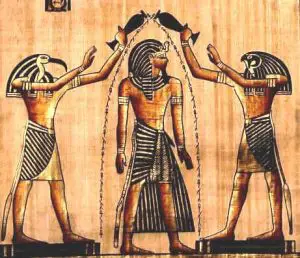The ancient Egyptian religion expressed the complexity of the relationships between humanity, the world, and the divine, with an inventiveness and subtlety that is without parallel. The gods and goddesses of Kemet embody a rich vocabulary of religious, mystical, and magical tools which were used to explore the frontiers of human spirituality.

The Egyptians held daily services to attend to the statue of the God by washing, clothing and anointing it with perfumes. The Pharaoh was thought to have direct access to the Gods – and one of his primary duties was to act as the intermediary between them and the people of Egypt.
The foundation rituals for temples actually consisted of eight separate rituals (or eleven during the Ptolemaic Period) of which the burying of foundation deposits was only one. The rituals were supposed to be conducted by the Pharaoh, but in reality, they were generally conducted on his behalf in most cases with the pharaoh taking on this role on a few of the more important structures.
Before dawn, the temple precinct was filled with the priesthood and other temple servants who were busily preparing offerings of food, drinks and flowers as well as other kinds of offerings which could differ depending on which deity they were intended for.
Ritual purity was of utmost importance. Everything and everyone which was to come into the presence of the god had to be purified. Pharaoh’s core ritual was the offering of Maat to his father Re. Maat had no sanctuary of her own but was worshipped in all Egyptian temples.
Magical Rituals
In magical rituals, the intention is to pacify, to grow, to shield or to destroy: protection, defence, lawful combat, execration, healing, the restoration of a state of affairs, the reversal of misfortune (caused by negative energies), healing, natural evolution etc. are specific examples. Magic aims at the Earth, religion at the sky. Magic is never without religion, but religion may reject magic. In many ways, magic is what makes religion possible.
They also had death Rituals and Ceremonies. The Death Rituals practised by the Ancient Egyptians included embalming and mummification. The mummies of dead Egyptians were placed in anthropoid (man-shaped) coffins which were decorated with a likeness of the deceased.
These are well-known Death Rituals but there were other extremely important death rituals which were practised including the ‘Opening of the Mouth ‘ ritual. The ceremony of the Opening of the Mouth is a renewal, a rebirth, and a restoration in one event. It is an act of creation and the supreme act of reaffirming life.
